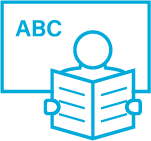Early Oral Language Comprehension, Task Orientation, and Foundational Reading Skills as Predictors of Grade 3 Reading Comprehension
The present five-year longitudinal study focused on children from pre-school to Grade 3. The developmental associations among oral language comprehension, task orientation, reading precursors, and reading fluency were examined, together with their role in predicting Grade 3 reading comprehension. Oral language comprehension, reading fluency, and task orientation each contributed uniquely to concurrent reading comprehension. Further, a reciprocal relationship was found between oral language comprehension and task orientation.
Authors: Janne Lepola, Julie Lynch, Noona Kiuru, Eero Laakkonen, & Pekka Niemi
Source: Lepola, J., Lynch, J., Kiuru, N., Laakkonen, E., & Niemi, P. (2016). Early oral language comprehension, task orientation, and foundational reading skills as predictors of Grade 3 reading comprehension. Reading Research Quarterly, 51(4), 373-390, doi: 10.1002/rrq.145
The present five-year longitudinal study focused on children from pre-school to Grade 3. The developmental associations among oral language comprehension, task orientation, reading precursors, and reading fluency were examined, in addition to their role in predicting Grade 3 reading comprehension. Oral language comprehension and task orientation were assessed from 90 Finnish-speaking students in pre-school, kindergarten, and Grade 3. Reading precursors were assessed at the first two timepoints and reading fluency at the third. Oral language comprehension, reading fluency, and task orientation each contributed uniquely to concurrent reading comprehension. Moreover, a reciprocal relationship was found between oral language comprehension and task orientation.
- Reading comprehension is based on two basic components: word decoding and oral language skills.
- Whereas skills such as phonological awareness and letter identification allow young readers to decode individual words, oral language skills (such as vocabulary and narrative comprehension) lay the foundation for deciphering meaning from text.
- When a reader constructs a coherent mental representation of a narrative, a number of cognitive skills are employed at the word, sentence, and text levels. These skills include activation of word meanings, understanding sentences, making inferences, monitoring comprehension, and understanding text structure.
- Children start to understand complex narratives from the age of 4 years.
What is task orientation?
- Task orientation is an umbrella term for a child’s tendency to accept challenging aspects of a learning task, which is observed as approaching, exploring, and mastering behaviours.
- Task orientation incorporates the pursuit of task-intrinsic goals (goals), such as gaining task-related understanding and sense of competence (self-efficacy).
- Concentration on the task at hand, positive emotional expressions that are related to the task (attitude), and persistence (agency) exemplify task orientations.
- At least a moderate expectation of success is inherent in task-oriented behaviours.
The study
The present five-year study had two aims:
- The longitudinal and concurrent roles of task orientation, oral language comprehension, reading precursors, and reading fluency in the prediction of reading comprehension in Grade 3 were examined.
- It was investigated whether oral language comprehension, reading precursors, and task orientation follow independent pathways or are reciprocally related to each other from preschool to Grade 3.
Participants
The study included 90 Finnish-speaking children, who were followed from age 4 years (preschool), to age 6 years (kindergarten), and to age 9–10 years (Grade 3). At Time 1 (age 4 years) and Time 2 (age 6 years), letter knowledge, phonological awareness, vocabulary, listening comprehension, and inference making were assessed. At Time 3 (Grade 3), listening comprehension, inference making, text-reading speed and accuracy, and reading comprehension were assessed. Task orientation was assessed by preschool, kindergarten, and Grade 3 teachers.
Findings
- Vocabulary knowledge at Time 1 was more strongly associated with concurrent listening comprehension than with letter knowledge or phonological awareness.
- The association between letter knowledge and phonological awareness was modest at age 4 years (r = 0.29), but strong at age 6 years (r = 0.62).
- Inference making was more strongly associated with vocabulary and listening comprehension than with letter knowledge.
- The stability of reading precursors from preschool to kindergarten and the stability of oral language comprehension from preschool through kindergarten to Grade 3 are evident from the data.
- The stability of task orientation was high from preschool to kindergarten (0.75), but lower from kindergarten to Grade 3 (0.40).
- In preschool, oral language comprehension is more strongly associated with reading precursors than with task orientation.
- Preschool task orientation and oral language comprehension contributed to kindergarten task orientation.
- Oral language comprehension in Grade 3 was predicted by kindergarten oral language comprehension and task orientation, whereas Grade 3 reading fluency was determined solely by kindergarten reading precursors.
- Concurrent measures of oral language comprehension, reading fluency, and task orientation each contributed unique variations to reading comprehension in Grade 3. Together, these accounted for 76% of the variance in Grade 3 reading comprehension.
- Preschool oral language comprehension had a significant and indirect effect on Grade 3 reading comprehension through kindergarten and Grade 3 oral language comprehension and kindergarten task orientation.
- Preschool reading precursors were associated with Grade 3 reading comprehension through kindergarten reading precursors and Grade 3 reading fluency.
- Preschool task orientation was indirectly related to Grade 3 reading comprehension through kindergarten task orientation and Grade 3 oral language comprehension.
Summary
- The findings suggest a reciprocal relationship between oral language comprehension and task orientation across time in the prediction of reading comprehension.
- The link between oral language comprehension and task orientation strengthened substantially from preschool to Grade 3.
- The modelling suggests that variations in reading comprehension is captured by the two components pertinent to the simple view of reading and task orientation.
- The results indicate that pathways to reading comprehension are propelled by behavioural factors relatively early—three years before the onset of formal reading instruction.
- Individual differences were conspicuously stable in oral language comprehension from age 4 to 9 years and in reading precursors from age 4 to 6 years.
- Continuity was observed in task orientation from preschool to Grade 3.
- The modelling of the links between reading precursors and oral language comprehension supported their developmental independence from preschool to kindergarten.
- The final model included narrative listening comprehension and inference making over the age range of 4–9 years, text reading fluency, and task orientation. This accounted for 76% of the variance in Grade 3 reading comprehension.
- A reliable prediction of Grade 3 reading comprehension can be based on listening comprehension and inference-making skills measured as early as the age of 4 years.
- It is suggested that task motivation facilitates text comprehension in at least two ways. First, strong task orientation implies an attempt to approach and master the learning task, simultaneously focusing on the meaning of instruction. Second, task orientation implies intellectual responsibility and high coherence standards and higher aspiration levels, which in turn results in better reading comprehension.
- Comprehension can be supported by discussing the explicit and implicit information in stories and identifying narrative elements and protagonists’ thoughts, feelings, and actions.



